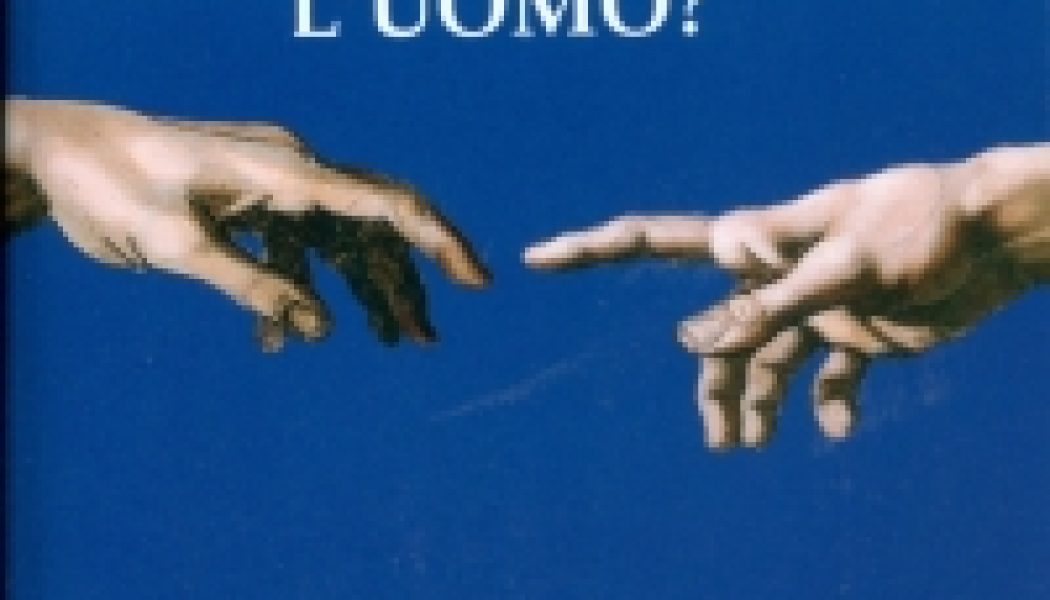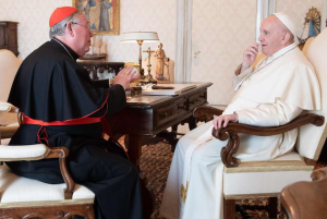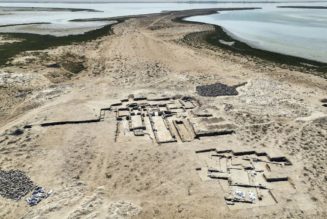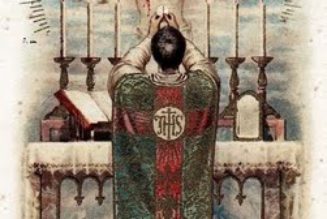
> Italiano
> English
> Español
> Français
> All the articles of Settimo Cielo in English
*
On account of a “slight indisposition,” Jorge Mario Bergoglio had to follow from home, via the web, the spiritual exercises for the beginning of Lent, held in the village of Ariccia in the Castelli Romani and ended today, Friday March 6.
But the pope must not have missed a beat of what was said by the preacher he ardently wanted this year: the Jesuit Pietro Bovati, 80, professor of Sacred Scripture at the Pontifical Biblical Institute of the Gregorian University, adviser to the congregation for the doctrine of the Faith and for twelve years a member of the Pontifical Biblical Commission, of which he is also secretary.
Bovati is a biblicist of some renown, highly esteemed by Pope Francis but extraneous to the circle of his courtiers. And he has recently sent to the presses what is perhaps the most beautiful document produced by the Holy See in the seven years of the current pontificate.
At the spiritual exercises, Bovati gave as the heading these words from Exodus: “The bush was burning with fire.” And he placed at the center of the reflection “the encounter between God and man,” from Moses to Jesus to the believer.
A theme that reechoes precisely the title of the document he edited: “What is man? An itinerary of biblical anthropology.”
The document has as its collective author the Pontifical Biblical Commission, which is headed by the prefect of the congregation for the doctrine of the faith and is made up of scholars of recognized value. Past members have included – limiting ourselves just to Jesuits – biblical scholars of the caliber of Carlo Maria Martini, Albert Vanhoye, Stanislas Lyonnet, Ignace de la Potterie, Klemens Stock, Ugo Vanni. And today none other than Bovati is its actual first in command.
Even in terms of its size, the document is out of the ordinary. It is a volume of 336 pages and in spite of this is compelling reading, unfortunately printed so far only in Italian and in a short run that was quickly exhausted. To define what man is according to the Holy Scriptures, it takes as its foundation the wonderful account of creation of Genesis 2-3 and traces its reappearances and thematic developments first in the books of the Torah and then in the prophets and wisdom literature, with particular attention to the Psalms, finally reaching their fulfillment in the Gospels and in the writings of the apostles.
What comes out of this is a fascinating itinerary of biblical anthropology, in full respect of the literary genres of Scripture and taking up its symbolic and narrative expressiveness.
But who wanted this document to be produced, and why?
In the latest issue of “La Civiltà Cattolica,” in the lead article, it is Bovati himself who replies. The document, he writes, was intended to be a “reference manual” in the faculties of theology, on the subject of biblical anthropology, and “was requisitioned by Pope Francis.”
In effect, if one scans the schedule of the Pontifical Biblical Institute on its official website, it turns out that during the current pontificate, between 2015 and 2018, the institute’s annual plenary sessions all had as their theme Biblical anthropology, the first three under the presidency of Cardinal Gerhard Müller when he was prefect of the congregation for the doctrine of the faith, the last under the presidency of his successor Luis F. Ladaria, and all four with secretary Bovati.
Undeservedly, the document has received scarce attention so far. A bit of noise came from the protests of those who saw in its treatment of the theme of homosexuality a surrender to the theories of “gender,” in particular where it reinterprets the account of Sodom in Genesis 19.
It’s true. As Bovati also repeats in “La Civiltà Cattolica,” the interpretation that the document gives is that “in the biblical account the city of Sodom is not blamed for being subject to unseemly sexual desires, but is rather condemned for its lack of hospitality toward the stranger, with hostility and violence worthy of the highest punishment.”
But in the ten pages that the document dedicates to the topic, there is also ample space for the very severe norms of Leviticus against homosexual behavior, as well as for Paul’s burning invective in chapter 1 of the letter to the Romans, without sugarcoating or submissive “reinterpretations,” while keeping intact, in a final note, the due “pastoral attention for individual persons.”
Further down on this page, as an invitation to read the document, an excerpt from Bovati’s article in “La Civiltà Cattolica” is presented.
But it is also helpful to recall – in order to appreciate the value and freedom of spirit of this great biblicist – the acute exegesis that he made two years ago, also in “La Civiltà Cattolica,” of the controversial invocation of the “Pater noster” which in Latin says: “Et ne nos inducas in tentationem.”
In Italian and English the translations used in the Masses closely follow the Latin formulation very closely and are respectively: “And do not lead us into temptation”, and “And lead us not into temptation.”
But “this is not a good translation,” Francis said on December 6 2017 in commenting on the “Pater noster” on TV 2000, the channel of the Italian episcopal conference. Which promptly fell into line, ultimately decreeing that as of the first Sunday of Advent in 2020 at the Masses it be said: “And do not abandon us in temptation.”
Against this background, it is striking that Bovati did not submit to Francis’s wishes at all, but instead thoroughly researched and explained – without illusory adaptations – the true original meaning of those words in the prayer taught by Jesus.
But let’s get back to “What is man?” Here is a passage from the introduction to the document that Bovati wrote in “La Civiltà Cattolica” on February 1, 2020.
*
BRIEF GUIDE TO READING THE ACCOUNT OF CREATION
by Pietro Bovati S.J.
We mention some innovative contributions from the document of the Pontifical Biblical Commission. For example, there is a traditional interpretation of Genesis 2:21-23 which states that woman was created after the man (male), on the basis of one of his “ribs.” The document carefully examines the terminology of the biblical narrator (such as where the translation of the Hebrew term “sela” with “rib” is criticized ) and an alternative reading of the event is suggested:
“Up to v. 20 the narrator speaks of ‘adam’ aside from any sexual connotation; the generic nature of the presentation requires us to give up imagining the precise configuration of this being, least of all resorting to the monstrous form of the androgyne. We are in fact invited to submit ourselves with ‘adam’ to an experience of not-knowing, so as to discover, by revelation, what the marvelous prodigy wrought by God is (cf. Genesis 15:12; Job 33:15). No one actually knows the mystery of his own origin. This phase of not-seeing is symbolically represented by the act of the Creator, who ‘brought a torpor upon “adam,” who fell asleep’ (v. 21): the slumber does not have the function of total anesthesia to allow for a painless operation, but rather evokes the manifestation of an unimaginable event, that by which from a single being (‘adam’) God forms two, man (‘is’) and woman (‘issah’). And this not only to indicate their radical similarity, but to suggest that their difference urges us to discover the spiritual good of (mutual) recognition, the principle of communion of love and an appeal to become ‘one flesh’ (v. 24). It is not the solitude of the male, but that of the human being that is assisted, through the creation of man and woman” (no. 153).
Another example. The problematic aspect inherent in the “ban” [on eating from one tree in the garden] is carefully treated in the exegetical commentary on Genesis 2:16-17, so as not to favor the idea that God arbitrarily opposes human desire. In reality the Creator manifests his liberality by making available to the creature “all the trees of the garden” (Genesis 1:11-12; 2:8-9). And yet:
“On the totality of the offer there is placed a limit: God asks man to refrain from eating the fruit of a single tree, situated next to the tree of life (Genesis 2:9), but quite distinct from it. The ban is always a limitation placed on the desire to have everything, on that lust (once called ‘concupiscence’) which man feels like an innate drive for fullness. Consenting to such a lust is the equivalent of mentally making the reality of the giver disappear; it therefore eliminates God, but at the same time also determines the end of man, who lives because he is a gift from God. Only by respecting the command, which constitutes a sort of barrier to the unequivocal unfolding of one’s own will, does man recognize the Creator, whose reality is invisible, but whose presence is signaled in particular by the forbidden tree. Forbidden not out of jealousy, but out of love, to save man from the folly of omnipotence” (no. 274).
Yet another example. The fact that the snake addressed the woman instead of the man (as it is narrated in Genesis 3) is often interpreted as a ploy of the tempter who would have chosen to attack the more vulnerable, more easily deceived person. However, it can be recalled that the female figure is in the Bible the privileged image of (human) wisdom:
“If we take this perspective, the encounter of Genesis 3 does not take place between a very astute being and a foolish one, but on the contrary between two manifestations of wisdom, and the ‘temptation’ is grafted precisely onto the high quality of the human being, who in the desire to ‘know’ runs the risk of sinning through pride, pretending to be God, instead of recognizing himself as a son, who receives everything from the Creator and Father” (no. 298).
One last example. It is customary to hear that God intervenes in sanctioning the sin of the progenitors with chastisements (Genesis 3:16-19); the punishment is in fact considered a dutiful act of justice, and this would result in an adequate reading of the biblical text. However, it should be noted that the first decision of the Creator is the curse of the serpent, associated with the promise of victory that the woman’s race will bring back upon the insidious threats of the tempter (Genesis 3:14-15). Moreover, the sufferings that afflict the potentialities of woman and of man are to be considered as dispositions of wisdom, willed by God because they are helpful for the human being, as they favor in the creature that humble disposition of the heart which is the way of life. […]
More generally, on the way in which Scripture presents God’s intervention in history when sin manifests itself, the modality of “judgment,” which leads to condemnation, does not constitute the most truthful form of restoring divine justice. Scripture attests rather that the Lord, as partner of the covenant, assumes the guise of the accuser (in the procedure of the “rib”) in order to favor the conversion of the sinner and graft onto this his act of forgiveness:
“The final event of the ‘rib’ therefore takes place as a renewed encounter between the beneficent will of the Father and the free consent of the son, an encounter of truth that highlights the love of the Lord and his saving power. The whole prophetic message of the Old Testament is a promise of this event, and the whole New Testament is the attestation of the beatifying fulfillment of what had been announced as a sense of history, with a manifestation that is not limited to Israel alone, but extends to all peoples, gathered under the same seal of mercy, in a new and perennial covenant” (no. 333).









